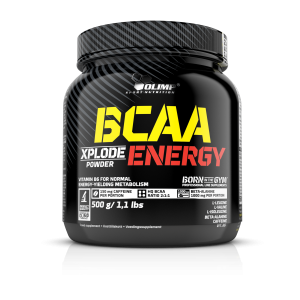Taurine – bulls-eye therapy

The compound was discovered by Tiedemann and Gmelin in 1827, in the bile of cattle, and was called taurine, from the Latin “taurus” – bull.
It is a non-proteinogenic amino acid: it does not form proteins, but simple peptides at the most. However, non-proteinogenic amino acids are no less important than those building proteins (proteinogenic), as exemplified by creatine and carnitine.
Modern medicine uses, and with great success, taurine in cardiology, oncology, hepatology, ophthalmology and neurology. But let us here not discuss the health issues and focus on aid in exercise capacity.
ANTI-CATABOLIC
Catabolism (protein breakdown) occurs most intensively during work (exercise) and sleep (post-absorption). When, after a meal, the blood levels of free amino acids go up, they intensively penetrate into the muscles and produce proteins – as muscle proteins store them. During exercise (training) or a long interval between meals (sleep), catabolic enzymes break down proteins to free the stored amino acids, because now they are needed in other tissues as well. Although free amino acids can be transported over long distances, the body often uses a trick. Amino acids are not transported in whole, but the nitrogen from them only, since the tissues that need them produce from their own amino acids by themselves. Nitrogen is released from amino acids and coupled with glutamine, which stores and transports it. In target tissues, a reverse reaction takes place, and the whole process is called transamination. The body destroys proteins and amino acids only until an appropriate level of glutamine is achieved – one necessary to supply the tissues in nitrogen. At a high level of glutamine, catabolic reactions stop. Because of the unique anti-catabolic activity of glutamine, it is readily used by athletes – especially strongmen.
The transporter and nitrogen storage function is also fulfilled by taurine. Approx. 50% of nitrogen outside proteins is stored in taurine. The more we provide of taurine, the less glutamine the body produces, which suggests that taurine may to some extent substitute glutamine.
The utilised taurine may be reconstituted from cysteine and methionine – amino acids derived mainly from the catabolism of muscle proteins. Since the muscle proteins store only small quantities of methionine and cysteine, the body destroys them in large numbers in order to secure the reconstitution of taurine. Synthesis of 1 g of taurine “costs” 120 g of protein. On the other hand: consumption of 1 g of taurine “saves” 120 g of muscle protein mass.
Yet another mechanism of anti-catabolic taurine activity has been described – lysosome stabilisation. It is the catabolic (lysosomal) enzymes that are responsible for catabolism in the body – “lysosomal” as they are stored in the intracellular organelles – lysosomes.
Physical exercise (training) and fasting (sleep) alter the cellular environment, leading to a destabilisation of lysosomal membranes and release of catabolic enzymes.
The non-proteinogenic amino acids are not incorporated into proteins by the genetic apparatus, however, after the synthesis by genes, they can bind and stabilise the protein molecules. Such bonds also occur in lysosomal membranes, which stabilises them, reduces the release of enzymes and inhibits catabolism. This is how phosphocreatine, acetyl L carnitine and taurine act. Taurine is the most important one – it accounts for 80% of the observed effect.
Yet another mechanism is worth noting – the inhibition of activity of catabolic hormones which, on the one hand, inhibit the activity of anabolic enzymes, and on the other hand, stimulate the catabolic ones. Taurine, through its effects on the brain, inhibits the release of pituitary hormone, ACTH, controlling the synthesis of catabolics: cortisol and serotonin.
ANABOLIC
A very potent anabolic hormone is insulin, produced and released by the pancreas in large quantities if the diet is rich in glucose.
Taurine stimulates the pancreas to produce and release insulin. However, its mode of action is different to that of glucose. The latter enters the cells of the pancreas and stimulates insulin synthesis through the products of its degradation, while the former most likely affects the receptors, capture points, located in the membrane of pancreatic cells. Just as excess glucose destroys pancreatic cells and eventually leads to their failure (diabetes), so doses of taurine protect, regenerate and improve pancreatic cells.
Taurine also affects the target tissues of insulin. Here, in contrast to glucose, it regenerates the insulin receptors and abolishes insulin resistance – increases the sensitivity of muscle tissue and reduces that of adipose one to the anabolic activity of insulin.
The effects on the pancreas, insulin and tissues are not a unique feature of taurine, but also of many organic sulphur compounds.
Since insulin is a hormone storing compounds valuable for the body, and sulphur – apart from sugars, fats and amino acids – is the most important of them, Nature has invented for it a specific transport system. Pancreas, which basically works only in the presence of glucose (and poorly in the presence of fats and amino acids), independently, without their participation, reacts strongly to organic sulphur compounds.
Organic sulphur compounds also have direct anabolic effects. This is indicated by the very fact that they regenerate pancreatic cells and target tissues. In addition, in some studies, anabolic effects have been observed induced by organic sulphur without the participation of insulin.
The CNS (brain) activity of taurine focuses on a neurotransmitter, gamma-aminobutyric acid, which is responsible for the production and release of another important anabolic hormone – somatotropin. It demonstrates that taurine is a special anabolic, stimulating both insulin and somatotropin. Special, since insulin and somatotropin co-intensify its anabolic activity towards the muscle tissue and abolish that towards the adipose one.
PSYCHOSTIMULANT
Taurine, in combination with caffeine, is used as a psychostimulant in energising beverages.
In the brain, taurine acts on the serotonergic system, serotonin-dependent, and GABAergic one, dependent on gamma-aminobutyric acid (GABA).
The inhibitory effect of taurine on serotonin may extend activity, as serotonin is responsible for relaxation. Stimulation of the GABAergic system with taurine closely resembles the effects of small doses of anxiolytics or alcohol – the period of vigil is elongated and the feeling of anxiety is alleviated. However, taurine has enormous advantage over drugs and alcohol here. Anxiolytics and alcohol at higher doses cause euphoria and intoxication, but taurine, even monstrously overdosed, stops at the alleviation of anxiety and elongation of vigil period.
Energisers are particularly popular with those practicing motor and extreme sports.
In other disciplines, one or two bottles before training significantly enhance the exercise capacity, as they act as psychomotor stimulants and increase confidence in own strength.
Sławomir Ambroziak, MSc Pharm
(Kulturystyka i Fitness Sport dla Wszystkich 11.2003)
BACK ›

